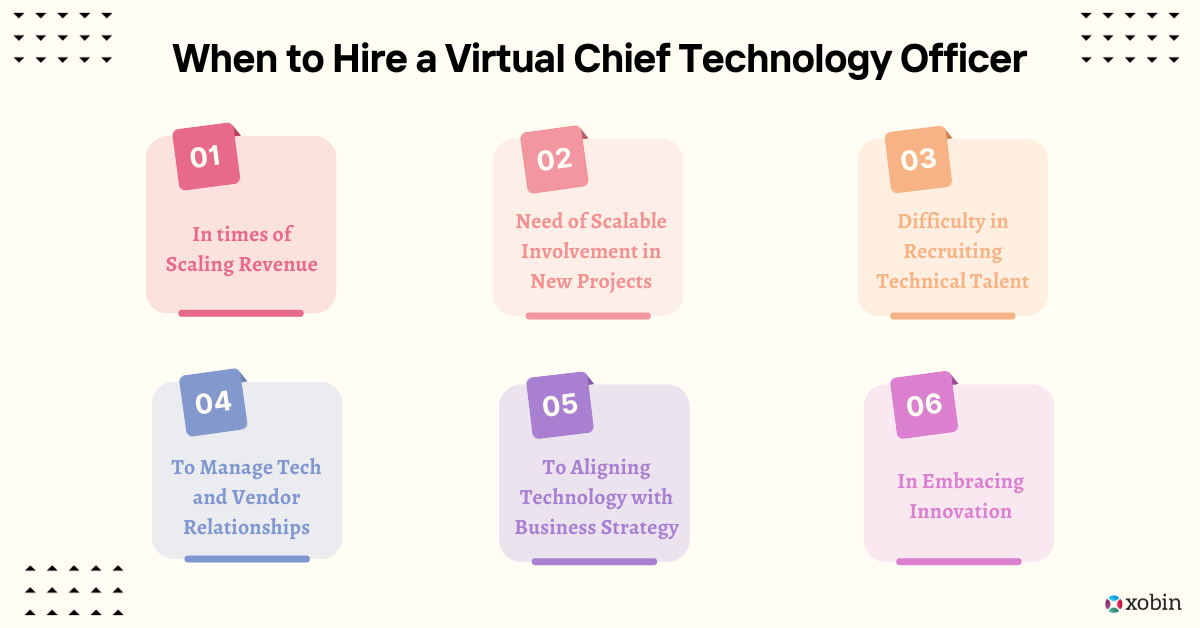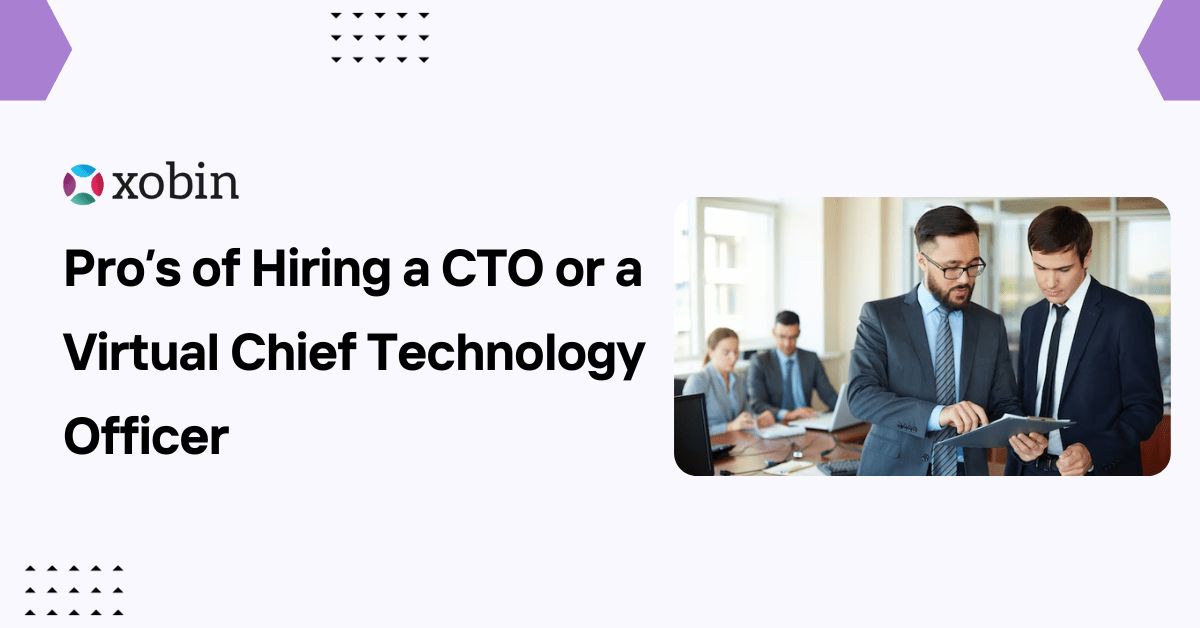In the intricate tech landscape, businesses seek efficiency, adaptability, and expert leadership. A Virtual Chief Technology Officer (vCTO) offers the strategic vision of a CTO with the flexibility of the digital age. Not confined to brick and mortar, this role redefines executive tech leadership to be both accessible and tailored to business needs. With AI-driven hiring solutions, companies can seamlessly identify the right vCTO, ensuring technology aligns with long-term business goals and innovation stays ahead of the curve.
Table of Contents
However, the prominence and rise of the vCTO underscore the shifts in contemporary business paradigms where agility, expertise, and cost-effectiveness are in harmonious convergence. So, in this blog explore invaluable benefits of bringing a CTO or vCTO on board.
When to Hire a Virtual Chief Technology Officer
As businesses progress and expand, certain indicators emerge, signaling that a CTO’s expertise and guidance are necessary. The role of a virtual chief technology officer (vCTO) is a testament to this evolving paradigm, providing companies with unparalleled operational agility. By having a vCTO at the helm, firms can dynamically adjust their technological oversight based on prevailing requirements, ensuring they’re neither overstretching resources nor being technologically underserved.
The option to hire coding skill experts or IT contractors further exemplifies this flexibility, allowing businesses to bring in specialized talent for specific projects without long-term commitments.

Hence, recognizing these signs is crucial for companies to make well-informed decisions about when to incorporate a CTO into their leadership team. Here are some key signs:
In times of Scaling Revenue
Crossing the millions revenue threshold signifies substantial growth and success. At this juncture, the technological demands of a company become more intricate, necessitating strategic oversight to ensure scalability and operational efficiency.
Need of Scalable Involvement in New Projects
The true beauty of a vCTO lies in its adjustable engagement level. Businesses aren’t tethered to a full-time commitment. Instead, they can calibrate the involvement of a vCTO based on project complexity, business cycle stages, or specific technological challenges, ensuring optimal deployment of expertise when most pertinent.
Difficulty in Recruiting Technical Talent
Acquiring and retaining highly skilled technical professionals can pose a challenge for many companies. If the organization struggles to secure adept developers in alignment with their goals, a CTO can make a substantial impact. Leveraging their extensive network, they can identify the right individuals to fill critical technology roles. For example, in terms hiring of candidates with technical expertise, a CTO will go through the current employees. After going through the existing employee base he will analyse their potential and the needed candidates with the skills. As a result, it helps in managing the budget on hiring and retention.
To Manage Tech and Vendor Relationships
As a company invests in development agencies or partners with technology vendors, having a CTO serve as a “tech lawyer” becomes invaluable. They ensure contracts are transparent, safeguard intellectual property, and facilitate efficient collaboration, thereby nurturing successful partnerships. In addition to above example the CTO’s will help in API webhooks and ATS like integrations of platforms which are a must need today.
To Aligning Technology with Business Strategy
When a company’s technological framework becomes increasingly integrated with its overall business strategy, the presence of a CTO is indispensable. They bridge the divide between technology and business objectives, translating the company’s vision into actionable tech initiatives that foster growth.
In Embracing Innovation
Innovation serves as the cornerstone of thriving businesses. For companies aspiring to lead in technological advancements, a CTO can serve as an agent of innovation. They stay abreast of emerging trends, evaluate new technologies, and guide the company in adopting innovations that set them apart from competitors.
Recognizing these signs and understanding the invaluable contribution a CTO can make empowers companies to make well-informed decisions about when to bring a CTO on board. Altogether, engaging traditional C-suite executives invariably means substantial overhead costs. Think office spaces, benefits, specialized equipment, and at times, even extensive relocation packages. So, their expertise and strategic guidance can wield a substantial impact on the company’s technological success and overall growth.
Expertise of a Virtual Chief Technology Officer
Technology is a vast and multifaceted domain, demanding a wide array of skills and expertise. Enter the virtual chief technology officer—a role synonymous with comprehensive technological know-how. These professionals, by virtue of their diverse engagements, often come equipped with insights from various sectors, platforms, and industries. For businesses, this means direct access to a wealth of knowledge without the overheads of a full-time executive. Furthermore, when firms choose to hire IT contractors for niche tasks, the vCTO ensures these specialists are optimally utilized. Also, harmonizing their unique skills with the company’s broader objectives.
- Tapping into a Pool of Varied Experiences: One might say that a vCTO is akin to a seasoned traveler, one who has journeyed through diverse tech terrains. Their myriad experiences across sectors, industries, and even geographical boundaries offer businesses a smorgasbord of insights. Such breadth and depth of knowledge, spanning multifaceted domains, render vCTOs invaluable, particularly when businesses are traversing unfamiliar territories or undertaking novel initiatives.
- Keeping Update of latest tech trends: The tech world is in perpetual flux, with innovations emerging at an unprecedented pace. vCTOs, owing to their wide-ranging engagements, invariably have their fingers on the pulse of the latest technological advancements. This ensures that the businesses they guide remain not just relevant but often at the cutting-edge, always prepared to harness the next wave of innovation.
- Technical Expertise: CTOs possess deep technical knowledge and expertise. They stay up-to-date with the latest advancements in technology and understand how these developments can impact the company. On the other hand, CTOs oversee the management and maintenance of the company’s technology infrastructure. So, this includes networks, servers, data storage, and cloud services.
So, a CTO’s impact extends far beyond the realm of technology, shaping the organization’s overall success in today’s technology-driven business landscape. In the above section, lets see how CTO’s play a big role in strategy and planning.
How Chief Technology Officer Helps in Strategy?
A clear vision and strategic direction are indispensable in the tech-driven business landscape. So, with a virtual chief technology officer spearheading the technological front, companies gain the advantage of focused, goal-oriented tech initiatives. Hence, virtual CTO is an amazing option offering a variety of CTO and C-Level Technology Management services. Beyond merely aligning tech projects with business objectives, a vCTO provides foresight, preempting industry trends and positioning the company for future success.
When a decision is made to hire IT contractors for particular projects, the vCTO’s overarching strategy ensures these initiatives seamlessly integrate. Hence, furthering the company’s tech agenda in a cohesive manner.
Strategic Vision of a Chief Technology Officer
Regulatory Compliance
Depending on the industry, CTOs may need to ensure that the company complies with relevant regulations and standards related to technology and data management.
Clear Tech Vision for the Company
In the labyrinthine world of technology, charting a clear path can be daunting. vCTOs shoulder this responsibility, crafting a lucid, tailored tech blueprint that aligns perfectly with a company’s goals, ethos, and market positioning. This vision serves as a compass, ensuring that every tech initiative or investment is both strategic and synergistic.
Effective Tech Stack Decision-making
Today’s tech milieu offers a bewildering array of tools, platforms, and solutions. Making sense of this vast array and selecting the most apt combination is where a vCTO shines. Through meticulous analysis, they pinpoint the precise tech stack that dovetails with a business’s needs, optimizing processes and minimizing redundancies. For example, a HR tech stack which fits in their requirements. Requirements like coding skill assessments and the compilers and vast and unique question libraries and many more.
Strategic Partnerships
CTOs may seek out strategic partnerships with technology companies, startups, or research institutions. For example they will partner up with organizations in HR tech domain for their strategic hiring goals. Hence, to stay at the forefront of industry developments chief technology officers will take such talks with HR managers and business partners regarding API or services.
Driving Customer and User Experience
CTOs drive innovation within the organization. They identify emerging technologies and trends that can give the company a competitive advantage and lead initiatives to integrate these innovations into the business. CTOs focus on improving the technology experience for customers and users. They gather feedback and data to make enhancements and drive user satisfaction.
Virtual Practices that Promote Collaboration
In an era where remote working and decentralized teams have become the norm, fostering a sense of unity and collaboration is crucial. vCTOs, equipped with a robust knowledge of virtual tools and best practices, sculpt an environment where geographically dispersed teams operate in lockstep, unified in purpose and function.
Conclusion
A Virtual Chief Technology Officer, as delineated here, is far more than a cost-saving measure. They represent a synthesis of adaptability, deep-seated expertise, precise strategy, and enriched collaboration. For companies sailing the often stormy seas of the tech domain, the guiding light of a CTO is not just desirable, it’s indispensable.






